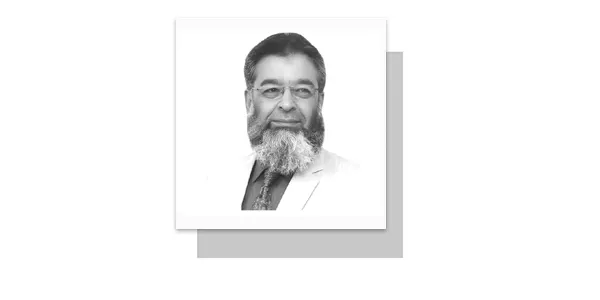Since the earliest flickers of my conscious memory, I have seen the several federal budgets of Pakistan presented with much fanfare and anticipation each June.
It was a season not unlike a grand festival, awaited with equal parts anxiety and hope—especially by the business community and government servants.
The former looked to it with a calculating eye; which commodities would bear the new burden of tax, what levies might shift the market tides in their favour.
The latter, more modestly, wondered how many increments would be awarded to their salaries and pensions.
The days leading up to the budget were filled with speculation and for some, strategic preparation.
There were traders who, by mere virtue of stocked goods in their warehouses, found themselves richer overnight, simply because the new duties declared from the treasury benches inflated the prices of their inventory.
In those days, the post-budget press conference of the finance minister held an air of solemnity and consequence.
Every word, every phrase, was weighed and measured by industrialists and economists alike.
In the National Assembly, thick budget booklets were distributed—heavy tomes filled with numbers and aspirations.
Few members of the House had the patience or interest to consult these volumes, but they were a treasure trove for journalists and parliamentary researchers, who would mine them for days and weeks to follow.
Time, however, has galloped on.
The budget—once an exercise in delicate statecraft and public sentiment—is now a behemoth whose size and scale are met with little more than weary nods.
Gone are the days when a slight increase of a few paisas in a commodity’s price would provoke spirited debates and media frenzies.
There was once a time when even a marginal adjustment in the cost of everyday items would be met with fiery protest or passionate defense.
That innocence—or perhaps that vigilance—seems lost.
In a recent sitting with the esteemed Mr.
Naeem Siddiqui, the former Librarian of the National Assembly and a walking encyclopedia of parliamentary chronicles, I was treated to memories of a different age—when budgets were not merely fiscal instruments but human stories.
He recalled an episode from the Ayub Khan era, when Mr.
Muhammad Shoaib served as the Finance Minister.
During the budget debate, a Bengali member named Afsaruddin Ahmad Khan stood and raised what seemed a minor but symbolic grievance.
He declared in the House that Coca-Cola, which had hitherto sold at 50 paise, was now being sold for 53 paise.
“You may not know,” he said to the minister, “because you drink it from government-hosted tables.
We drink it from our own pockets.
” It was an unpretentious statement, but it carried the force of truth.
In those days, market rates did not fluctuate daily and when they did, it was usually the state that prompted the change.
Finance Minister Shoaib, perhaps flustered by the unexpected specificity of the critique, replied with a modest admission.
“Only one item, the postcard, which was priced at three paise, has now been raised to five.
” Yet even this small increase prompted a strong reaction.
When the cost of a Bottle of kerosene oil rose from 25 paisa to 28 paisa, a trade unionist and labour leader from East Pakistan named Mehboob-ul-Haq voiced his concern with notable eloquence.
He reminded the House that such correspondence was not merely commercial, but a vital thread in the social and emotional fabric of the country.
“Those who send letters in envelopes can afford them; the poor rely on postcards,” he remarked.
There was another instance where kerosene oil—a staple in the homes of the common man—saw a nominal increase of three paise.
Again, Mehboob-ul-Haq rose with a clarity of thought rarely heard today.
He pointed out that in the dimly lit huts of East Pakistan, where kerosene lamps were the only source of light, this increase would extinguish not just flame but hope.
“When the lamps do not burn,” he warned, “the millions spent on family planning will go to waste.
” The Finance Minister was convinced by their arguments and withdrew the 3 paise increase.
Over the decades, Pakistan’s federal budgets have ballooned from modest beginnings to colossal figures.
In Ayub Khan’s era, the budget was a humble Rs.2–3 billion.
By Zulfikar Ali Bhutto’s time, it crossed Rs.20 billion, expanding the state’s role.
General Zia’s regime took it past Rs.100 billion, influenced by regional conflicts and aid inflows.
The 1990s saw the democratic governments of Nawaz Sharif and Benazir Bhutto push spending beyond Rs.300 billion.
Under General Musharraf, it exceeded Rs.1 trillion.
By 2013, it had reached Rs.3 trillion and during Imran Khan’s tenure, it surged beyond Rs.7 trillion.
Now, the federal budget has soared to an unprecedented Rs.18 trillion.
Yet, over Rs.9.5 trillion goes to debt servicing, with little left for development or the everyday citizen.
Despite the technical complexity and massive outlay, the lives of common people remain burdened.
The question lingers; is the budget still a reflection of public service, or merely a ritual of numbers?
It must go beyond forecasts—it must restore trust, touch lives and reignite the spirit of inclusive governance.
A national budget should be more than arithmetic; it should be an instrument of compassion and collective hope.
—The writer is contributing columnist, based in Islamabad. (ememiqbal68@gmail.com)


















